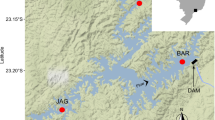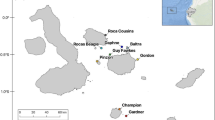Abstract
Estimates of feeding rates, alimentary tract structure and temporal patterns of food processing obtained from twelve species of nominally herbivorous fishes on the northern Great Barrier Reef were compared. These included members of the families Acanthuridae, Scaridae and Kyphosidae. Based on an analysis of diet and short-chain fatty acid (SCFA) profiles from a previous study we initially partitioned the twelve species into four dietary categories, as follows: (a) Category 1: herbivores with a diet of macroscopic brown algae and high SCFA profiles in the hindgut region (Naso unicornis, Kyphosus vaigiensis); (b) Category 2: herbivores feeding on turfing and filamentous red and green algae with moderate SCFA profiles in the hindgut region (N. tonganus, K. cinerascens, Zebrasoma scopas, Acanthurus lineatus); (c) Category 3: zooplankton feeders with moderate SCFA profiles (N. vlamingii, N. brevirostris); (d) Category 4: species feeding on detrital and sedimentary materials with low levels of SCFA (Chlorurus microrhinos, Scarus schlegeli, Ctenochaetus striatus, A. olivaceus). The purpose of this comparison was to determine whether measures of feeding activity, alimentary tract structure, and food processing were concordant with diet. A dichotomy in feeding rates was observed. Species with a diet of algae and zooplankton (categories 1–3) had slower feeding rates than those feeding on detrital aggregates and sediment (category 4). The pattern of food processing also followed the same dichotomy with species of categories 1–3 retaining food in the alimentary tract overnight and commencing the feeding day with substantial amounts of food in the intestine and hindgut. Category-4 species commenced the feeding day with empty alimentary tracts suggesting a rapid turnover of gut contents. Within the herbivorous and zooplankton-feeding species neither alimentary tract structure nor food processing mode were predicted by diet or SCFA profiles. A hindgut fermentation chamber was present in K. vaigiensis but not in N. unicornis, a species with high levels of SCFA in the hindgut region and a diet of brown macroscopic algae. In contrast N. vlamingii, with a diet dominated by animal matter, retained large amounts of food material in a hindgut chamber over the entire feeding cycle. In tropical perciform fishes, herbivory and fermentation are not associated with the alimentary tract structures that characterise herbivorous terrestrial vertebrates. Estimates of the abundance of the different groupings of nominally herbivorous fishes indicated that the dominant elements in the reef grazing and browsing fauna were consumers of detrital and sedimentary materials. These could not be classified as herbivores. Members of this group were dominant in all habitats investigated. Explicitly herbivorous taxa were a minority component in all habitats investigated.





Similar content being viewed by others
References
Bellwood DR (1994) A phylogenetic study of the parrotfishes, family Scaridae (Pisces: Labroidei), with a revision of genera. Rec Aust Mus, Suppl 20:1–86
Bellwood DR (1995) Direct estimate of bioerosion by two parrotfish species, Chlorurus gibbus and C. sordidus, on the Great Barrier Reef, Australia. Mar Biol 121:419–429
Bellwood DR, Choat JH (1990) A functional analysis of grazing in parrotfishes (family Scaridae): the ecological implications. Environ Biol Fish 28:189–214
Choat JH (1991) The biology of herbivorous fishes on coral reefs. In: Sale PF (ed) The ecology of fishes on coral reefs. Academic, San Diego, pp 120–155
Choat JH, Axe LM (1996) Growth and longevity in acanthurid fishes; an analysis of otolith increments. Mar Ecol Prog Ser 134:15–26
Choat JH, Bellwood DR (1985) Interactions amongst herbivorous fishes on a coral reef: influence of spatial variation. Mar Biol 89:221–234
Choat JH, Clements KD (1993) Daily feeding rates in herbivorous labroid fishes. Mar Biol 117: 205–211
Choat JH, Clements KD (1998) Vertebrate herbivores in marine and terrestrial environments: a nutritional ecology perspective. Annu Rev Ecol Syst 29:375–403
Choat JH, Clements KD, Robbins WD (2002) The trophic status of herbivorous fishes on coral reefs. I. Dietary analyses. Mar Biol 140:613–624
Clements KD (1997) Fermentation and gastrointestinal microorganisms in fishes. In: Mackie RI, White BA (eds) Gastrointestinal microbiology, vol 1. Gastrointestinal ecosystems and fermentations. Chapman and Hall, New York, pp 156–198
Clements KD, Choat JH (1995) Fermentation in tropical marine herbivorous fishes. Physiol Zool 68:355–378
Clements KD, Choat JH (1997) Comparison of herbivory in the closely-related marine fish genera Girella and Kyphosus. Mar Biol 127:579–586
Clements KD, Gray RD, Choat JH (2003) Rapid evolutionary divergences in reef fishes of the family Acanthuridae (Perciformes: Teleostei). Mol Phylogenet Evol 26: 190–201
Crossman DJ, Choat JH, Clements KD, Hardy T, McConochie J (2001) Detritus as food for grazing fishes on coral reefs. Limnol Oceanogr 46:1596–1605
Harmelin-Vivien M (2002) Energetics and fish diversity on coral reefs. In: Sale PF (ed) Coral reef fishes. Dynamics and diversity in a complex ecosystem. Academic, San Diego, pp 265–274
Horn MH (1992) Herbivorous fishes: feeding and digestive mechanisms. In: John DM, Hawkins SJ, Price JH (eds) Plant-animal interactions in the marine benthos. Syst Assoc Spec Vol 46:339–362
Jones RS (1968) Ecological relationships in Hawaiian and Johnston Island Acanthuridae (Surgeonfishes). Micronesica 4:309–361
Klanten SO, Van Herwerden L, Choat JH, Blair D (2004) Patterns of lineage diversification in the genus Naso (Acanthuridae). Mol Phylogenet Evol (in press)
Manly BFJ (1994) Multivariate statistical methods: a primer. Chapman and Hall, London
McNab BK (2002) The physiological ecology of vertebrates. Comstock, Ithaca
Meekan MG, Choat JH (1997) Latitudinal variation in abundance of herbivorous fishes: a comparison of temperate and tropical reefs. Mar Biol 128:373–383
Montgomery WL, Myrberg AA Jr, Fishelson L (1989) Feeding ecology of surgeonfishes (Acanthuridae) in the northern Red Sea, with particular reference to Acanthurus nigrofuscus (Forsskål). J Exp Mar Biol Ecol 132:179–207
Mountfort DO, Campbell J, Clements KD (2002) Hindgut fermentation in three species of New Zealand marine herbivorous fish. Appl Environ Microbiol 68:1374–1380
Polunin NVC (1996) Trophodynamics of reef fisheries productivity. In: Roberts CM, Polunin NVC (eds) Reef fisheries. Chapman and Hall, New York, pp 113–135
Polunin NVC, Harmelin-Vivien M, Galzin R (1995) Contrasts in algal food processing among five herbivorous coral reef fishes. J Fish Biol 47:455–465
Purcell SW, Bellwood DR (1993) A functional analysis of food procurement in two surgeonfish species, Acanthurus nigrofuscus and Ctenochaetus striatus (Acanthuridae). Environ Biol Fish 37:139–159
Robertson DR, Gaines SD (1986) Interference competition structures habitat use in a local assemblage of coral reef surgeonfishes. Ecology 67:1372–1383
Robertson DR, Polunin NVC, Leighton K (1979) The behavioural ecology of three Indian Ocean surgeonfishes (Acanthurus lineatus, A. leucosternon and Zebrasoma scopas): their feeding strategies, and social and mating systems. Environ Biol Fish 4:125–170
Sano M (1984) Food habits of teleostean fishes in Okinawa Island, Southern Japan. Bulletin number 25, The University Museum, The University of Tokyo
Stevens CE, Hume ID (1995) Comparative physiology of the vertebrate digestive system, 2nd edn. Cambridge University Press, Cambridge
Vermeij GJ, Lindberg DR (2000) Delayed herbivory and the assembly of marine benthic ecosystems. Paleobiology 26:419–430
Wilson S (2002) Nutritional value of detritus and algae in blenny territories on the Great Barrier Reef. J Exp Mar Biol Ecol 271:155–169
Wilson S, Bellwood DR (1997) Cryptic dietary components of territorial damselfishes (Pomacentridae, Labroidei). Mar Ecol Prog Ser 153:299–310
Wilson SK, Burns K, Codi S (2001) Sources of dietary lipids in the coral reef blenny Salarias patzneri. Mar Ecol Prog Ser 222:291–296
Winterbottom R, McLennan DA (1993) Cladogram versatility: evolution and biogeography of acanthuroid fishes. Evolution 47:1557–1571
Acknowledgements
We thank D. Bellwood, S. Wilson, G. Russ, R. Robertson, David Crossman, Carol Diebel, Ian Hume, Tony Larkum, Linn Montgomery, Michael Slaytor, Ed Stevens, Alwyn Rees, and Lindsey Zemke-White for helpful comments and criticism. J. Ackerman, M. Marnane and V. Gleeson provided valuable help in the field and with data preparation. L. Axe was responsible for the field logistics, initial data collection and processing. Sula Blake and Lucy Smith provided original artwork for the figures. N. Moltschaniwsky provided advice on statistical procedures. Funding was provided by the Australian Research Council, and the James Cook University (JCU) internal funding program. The Australian Museum provided essential facilities through the Lizard Island research station. The collection and processing of material was covered by Ethics Permit A504, JCU Ethics Committee.
Author information
Authors and Affiliations
Corresponding author
Additional information
Communicated by G.F. Humphrey, Sydney
Rights and permissions
About this article
Cite this article
Choat, J.H., Robbins, W.D. & Clements, K.D. The trophic status of herbivorous fishes on coral reefs. Marine Biology 145, 445–454 (2004). https://doi.org/10.1007/s00227-004-1341-7
Received:
Accepted:
Published:
Issue Date:
DOI: https://doi.org/10.1007/s00227-004-1341-7




